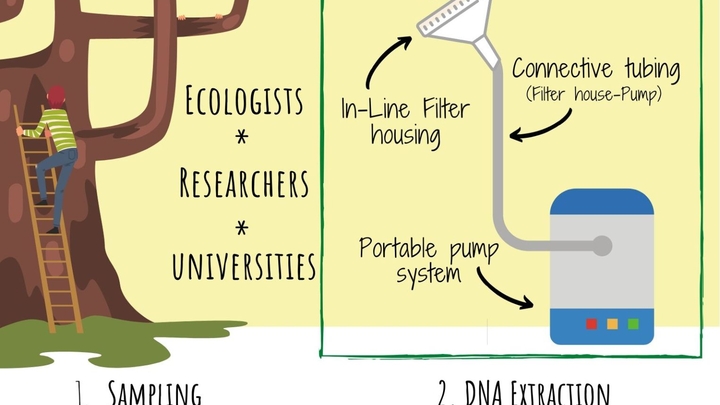Airborne DNA (abDNA) Sampler
The Problem
For hard-to-survey species (e.g. elusive, nocturnal, burrowing, or cryptic), obtaining data on ecological parameters such as population size and distribution can be challenging. Based on an analysis of terrestrial species on the IUCN Red List, 28% are considered to be data deficient (DD), meaning there is insufficient information for an accurate assessment of conservation status to be made. Many of these, including over 700 mammal species, fall within the hard-to-survey category and are also in the EDGE species lists. Developing novel techniques for acquiring accurate ecological data is paramount to understanding, monitoring, and mitigating the effects of conservation threats to vulnerable species. Environmental DNA (eDNA) approaches are helping to improve the efficacy of data acquisition and have been particularly successful when it comes to studying species from aquatic habitats. The novel tool that we propose will significantly increase the scope of data collection and non-invasive monitoring for hard-to-survey, terrestrial mammals.
Our Proposal
We propose the Airborne DNA (abDNA) Sampler; a tool for collecting DNA from airborne biological materials containing genetic information (e.g. shed skin and hair, faeces and saliva) which then continues to persist in air. The sampler design will consist of three components; a filter-housing, a portable pump system, and tubing to connect the two. Reducing contamination, along with portability in the field were two key considerations of the prototype design process. Over the past year, we have taken the first steps in proof-of-concept and managed to obtain some positive qPCR results of airborne samples from captive bats. The prototype proposed will allow us to validate our method. We then intend for the abDNA sampler to become available to universities, independent researchers and ecologists. Here we have spotted an opportunity to expand on eDNA methods, to create a novel surveying and monitoring tool for presence-absence surveys and wildlife identification.
We Assume that...
1. Ecologists and researchers will find the abDNA sampler useful, and there is a market opportunity.
2. The data collected using the abDNA sampler will lead to successful conservation outcomes.
3. The prototype design will be scalable to a commercial level.
Constraints to Overcome
To date, eDNA methods do not cover terrestrial air sampling, and there is currently no published research on recovering DNA from the air for the purposes of presence-absence surveys and wildlife identification. This may not be from lack of trying, rather the equipment to do so is not available. Surveying and monitoring hard-to survey species using traditional ecological techniques (e.g. visual counts, camera traps, and endoscopes) are often unfeasible, as they require costly equipment and expertise, and are time and labour intensive. Additionally, not everyone has access to lab facilities for extraction and analysis of samples, therefore we intend to offer this as a service. Our abDNA sampler will offer a quicker, cheaper method, and increased taxonomic resolution and species detection probabilities.
Current Work
1. Refine our prototype design further. 2. Continue to validate the abDNA sampler and method by recovering abDNA from hard-to-survey UK mammal species such as bats. 3. Ensure data collected is ecologically valid.
Current Needs
Funds for taking our prototype to the next development stage (e.g. CAD), testing, carrying out more studies and research, expertise in developing tools for eDNA collection.

